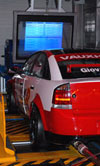Winning with dynos
 Leading race engine manufacturer Engine Developments, of Rugby, Warwickshire, commissioned a new dynamometer data acquisition system earlier this year.
Leading race engine manufacturer Engine Developments, of Rugby, Warwickshire, commissioned a new dynamometer data acquisition system earlier this year.
The system incorporates the latest hardware and software technology in order to improve the dynamometer data acquisition capability to the benefit of the company internally and to its customers.
The company, which manufactures Judd racing engines, has three dynamometer cells, all of which contain a Froude G490 water brake dynamometer. The new system is portable and can be configured for, and run in, each cell independently.
Judd engines have dominated the Le Mans customer engine market in recent years, in terms of sales, performance and reliability, so clearly the system is working.
For the last 15 years the company have used a Magnetti Marelli data acquisition system which operated satisfactorily, but after Le Mans 2008 EDL decided that a more flexible and modern system was required, as John Judd Jr explains;
“The previous Marelli dynamometer data acquisition system was entirely independent of the engine and ECU; it would log all of the dynamometer parameters, but that was it. It had a limited number of channels and was not very configurable.
“Our new dynamometer data acquisition system uses a Motec ADL combined dashboard / data logger. This is an up to date system that offers us excellent flexibility; the software is easily configurable and it can log up to 26 channels; we actually use 20 from the dyno. The main benefit though is that we can export data from an engine ECU via a CAN link into our Motec system. This means that we have one system which is logging everything we need from the engine and the dynamometer.
“All our sports car engines run EFI Euro 12 ECUs, which have built in data acquisition systems. That is a really useful feature on an ECU from an engine manufacturer’s perspective as it allows us to monitor engine parameters independently of the team.
“We installed the system earlier this year and already we’re seeing the benefits. The new system makes it much easier to identify faults during running, and if an engine problem occurs during the dyno test or on PDI (pre-delivery inspection) we can very quickly analyse the engine and dynamometer data.
“The other big advantage is seen during the testing of engines which are run on ECUs which don’t have on board data logging; and we have plenty of those! A typical example would be a 1990s Formula One engine; depending on the individual case we can now more easily adapt the new Motec system to log data from the engine sensors.
“We have an obligation to supply a high quality engine to the customer and having this additional capability benefits us both. The data allows us to check many more parameters before the engine is delivered and should any problems subsequently arise in the car, it helps in the analysis.
EDL have, typically, adapted the system to their own requirements.
In each dynamometer cell, two LCD screens display output from the new system. The dashboard, which actually is the data logger, is mounted on an in-house control box which has switches incorporated in it allowing the operator to change between different pre-set screen configurations for warm up and power test. The operator can also reset alarms and set timing beacons in the data.
John Judd Jr explains the choice of Motec;
“The Motec system is a cost effective solution; dynamometer testing is an expensive business. We have to be able to offer customers a service they can be entirely confident with, but at the same time we have to sell dynamometer time in a competitive environment.
“In commissioning the new dynamometer data acquisition system we’ve achieved our aims; it’s a modern, flexible system which we can adapt to future requirements.”
Written by Tom Sharp.